KANSAS CITY — Lost restaurant business made a big impact on Shelton, Wash.-based Taylor Shellfish Farms, but by mid-2021, things were starting to return to normal, said Bill Dewey, the company’s director of public affairs.
“It’s been a challenging year, but, like a phoenix rising up, our company operations are beginning to shine again,” he said. “Over the past three months, we’ve seen our production and sales volumes achieve similar levels as 2016 and 2017, our peak revenue years.”
Virtually every product category at Taylor is running at a full capacity, Dewey added, as the company works to sustain with smaller crews. That’s thanks in large part to consumers making the switch and getting on board with retail purchases of shellfish.
Restaurants reopening has obviously helped, too.
“That will help bolster our specialty oyster sales that are shucked and eaten raw on the half shell,” Dewey said. “Many people are intimidated by opening their own oysters so sales for these specialty oysters really suffered during the pandemic.”
Like so many businesses, Taylor is having a big challenge with staffing, he added. Fortunately, everyone who is on the Taylor team has worked hard to make up for the deficit, allowing the company to return to its previous levels of success. “We still have numerous challenges in front of us, but we feel equally encouraged with what the future holds.”
One standout performer has been the company’s clam operations, Dewey said. From March through June, clam harvest surpassed 400,000 pound per month — the first time that’s ever happened at the company.
Clams, unlike oysters, are an easier sell for consumers moving from foodservice to retail.
“The clam market has been strong. During the pandemic, people have thankfully taken to cooking more seafood at home and clams are easy to prepare.”
With the labor shortage, Taylor was only able to achieve those numbers with mechanized harvest and efficient packaging equipment, Dewey said. Taylor has built a few clam harvesting machines over the past decade and they have allowed for very efficient harvest, and the company’s 10-chute weigh-bagger from Italy allows workers to package small retail bags of clams efficiently.
Heatwave hits NW mollusks hard
The record-breaking heat that hit the Pacific Northwest from June 23 to 28 caused harm to many intertidal shellfish and invertebrate species on Washington beaches.
On many beaches, species such as cockles, varnish clams, butter clams, and native littleneck clams—normally buried out of sight—popped to the surface of the substrate in large numbers, according to the University of Washington.
Manila clams were also impacted in some areas. Surfaced clams were observed to be gaping, a sign of stress, or had already died from the effects of the heat. Some Pacific and Olympia oysters initially appeared to survive the heat but died in subsequent days, perhaps weakened by the extreme temperatures and unable to recover.
Many mussels along the tidelands and on rocks died (however, mussels on pilings and on rafts and floats in some areas appeared to fare better). Mortalities are continuing to unfold and attempts to document continuing impacts are ongoing. It may be a month or more before we see the full extent of loss.
The event is being considered a once-in-a-lifetime occurrence because of the coincidence of record high temperatures and midday extreme low tides, leading to unusually high lethal effects on intertidal sea life. This is possibly the first documented shellfish mortality event of this magnitude in modern times.
Check out our seafood page, for more industry news.

